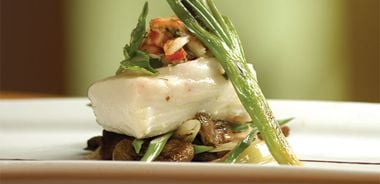Dungeness Crab Crusted Halibut

The sweetness of the crab combined with the richness of the halibut and earthy appeal of fresh chanterelles makes this an elegant but simple affair. Experiment with other seasonal mushrooms to add even more local flavour. Pair this fare with some heirloom beets and field green beans, lightly steamed, and serve with a medium Riesling.
4-5 oz (115-125 g) halibut filet, centre cut
4 oz (115 g) Dungeness crab meat, fresh (or premium canned)
2 cups (500 mL) BC chanterelle mushrooms
2 Tbsp (30 mL) olive oil
2 Tbsp (30 mL) unsalted butter
6 shallots, sliced thin
4 green onions, cut on bias
4 leaves basil, sliced thin
2 tsp (10 mL) honey
4 sprigs thyme
Salt and pepper to taste
Preheat oven to 350 F (180 C). In small bowl combine crab meat, basil, and honey. Season to taste with salt and pepper. Make incision in top of each piece of halibut (roughly 2/3 its thickness) and stuff with crab mixture. Place halibut on parchment paper in baking dish and bake at 350 F (180 C) for 6 to 8 minutes or until fish begins to flake. Remove and tent with foil atop warm stove. Halibut should be served medium in temperature.
Be sure chanterelles are clean and free of debris. Trim stems of fibrous ends. In a saucepan over medium-high heat, begin to sweat mushrooms with shallots in olive oil and unsalted butter until tender. Once shallots are translucent (4 to 6 minutes), add thyme and green onions. Season to taste.
Arrange chanterelle mixture in centre of each plate, and top with halibut filet. Finish with a sprinkle of sea salt and a drizzle of olive oil. Serves 4.
source: "The Life of Riley", alive #285, July 2006




